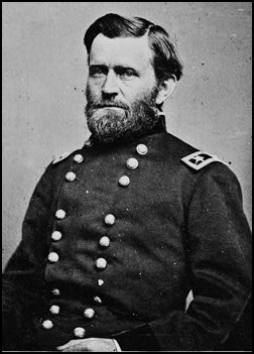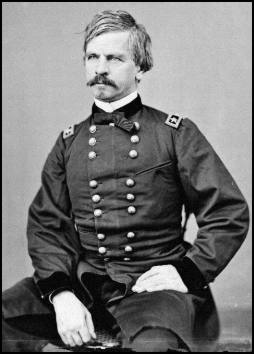 For some time now I’ve looked at Ulysses Grant’s Vicksburg Campaign as perhaps the most important of the Civil War. After all, the results were spectacular. Grant eliminated about 40,000 Confederate soldiers (captured and paroled), captured 172 cannons and 60,000 rifles, and not to mention the city itself. At a time when the complete neutralizing or destruction (the “decisive victoryâ€) of an opposing army simply didn’t happen, at least not since the days of Napoleon, Vicksburg was indeed a great victory as Lincoln even noted. However, perhaps the most significant result of the campaign was the Union closing of the Mississippi gap.
For some time now I’ve looked at Ulysses Grant’s Vicksburg Campaign as perhaps the most important of the Civil War. After all, the results were spectacular. Grant eliminated about 40,000 Confederate soldiers (captured and paroled), captured 172 cannons and 60,000 rifles, and not to mention the city itself. At a time when the complete neutralizing or destruction (the “decisive victoryâ€) of an opposing army simply didn’t happen, at least not since the days of Napoleon, Vicksburg was indeed a great victory as Lincoln even noted. However, perhaps the most significant result of the campaign was the Union closing of the Mississippi gap.
Grant was not the only one who was actively trying to close the gap. From March to May 1863 there was an attempted coordinated offensive movement along the Mississippi between Ulysses Grant and Nathaniel Banks. When Banks took over for Benjamin Butler he immediately reoccupied Baton Rouge by the end of 1862. By January of 1863, Grant was at Milliken’s Bend, just above Vicksburg.
The Confederacy was desperately trying to keep open the Mississippi gap: a 240-mile stretch of the river between Vicksburg in the north and Port Hudson in the south from which flowed Texas beef and other supplies. Grant was aided by Admiral David D. Porter’s river fleet and Banks by Admiral David G. Farragut’s Gulf fleet.
Lincoln and the Union high command wanted the Mississippi gap closed and for good reason. It was an important lifeline of food to the Confederacy. The lower Mississippi was a flood zone in early 1863. This would allow Banks to move up the Red River and circumvent Port Hudson, placing himself in the gap. If Grant would then send part of his army south and link up with Banks, they would be able to overwhelm Port Hudson and its 5,000 or so defenders. After its reduction both forces would move north and take on Pemberton and Vicksburg.
 Probably because of his eventual failure during his disastrous 1864 Red River Campaign, Banks efforts in 1863 to open the gap have been for too long overlooked by historians. Bruce Catton in Grant Moves South wrote that, “the plan for a joint move against Port Hudson had always been more the expression of a pious hope than the precise formulation of a working military program.†(p.433) I think Catton is too hard on Banks (and Halleck). There were several factors going against the joint movement, communication being the most significant. It took weeks for communication from Banks to get to Halleck, and from Grant to Halleck wasn’t a lot better. Banks also had only about 40,000 total men in his department, and therefore manpower was an issue for him. The simple fact is that Grant never seriously considered Port Hudson as an objective. He wanted Vicksburg, and besides taking it would ultimately achieve the same objective. But if it had failed might Grant have jeopardized the entire region? Grant’s move was bold, but there was perhaps an alternative that would have almost guaranteed success. Banks would eventually fight his way to Port Hudson, but his force was too small to take it.
Probably because of his eventual failure during his disastrous 1864 Red River Campaign, Banks efforts in 1863 to open the gap have been for too long overlooked by historians. Bruce Catton in Grant Moves South wrote that, “the plan for a joint move against Port Hudson had always been more the expression of a pious hope than the precise formulation of a working military program.†(p.433) I think Catton is too hard on Banks (and Halleck). There were several factors going against the joint movement, communication being the most significant. It took weeks for communication from Banks to get to Halleck, and from Grant to Halleck wasn’t a lot better. Banks also had only about 40,000 total men in his department, and therefore manpower was an issue for him. The simple fact is that Grant never seriously considered Port Hudson as an objective. He wanted Vicksburg, and besides taking it would ultimately achieve the same objective. But if it had failed might Grant have jeopardized the entire region? Grant’s move was bold, but there was perhaps an alternative that would have almost guaranteed success. Banks would eventually fight his way to Port Hudson, but his force was too small to take it.
Banks initial move up the Red River in early 1863 was actually brilliantly achieved. By April 20 he was 150 miles north of New Orleans and was driving the enemy back in handsome style. When Grant Landed south of Vicksburg at Port Gibson (May 1), it might have been the more prudent move to turn south and help Banks. The gap would be closed and a major lifeline of the Confederacy cut. There would have been time then to turn north and take on Vicksburg. Instead, Grant allowed the gap to stay open for another 2 months. Port Hudson surrended to Banks only after Vicksburg fell.
To be continued…
Nice reading about The Closing of the Mississippi Gap.
Are you intressted of American civil war 1861-1865.
I own a site about American civil war 1861-1865 and have a discussion forum for the ACW it´s free to reg.
Regards Ann
continu with your great blog
Nice reading about The Closing of the Mississippi Gap.
Are you intressted of American civil war 1861-1865.
I own a site about American civil war 1861-1865 and have a discussion forum for the ACW it´s free to reg.
Regards Ann
http://www.factasy.com/civil_war/
continu with your great blog
Thanks Ann I’ll check it out!
Chris
Chris,
Nice post. However, I think it is inaccurate to say Port Hudson had “5,000 or so defenders”. The size of the force holding Port Hudson varied in size during early 1863 from a peak of over 15,000 in March to about 7,000 when Banks beseiged it in May.
Yours truly,
Edmund Baldwin
Edmund, thanks for the clarification.
Chris